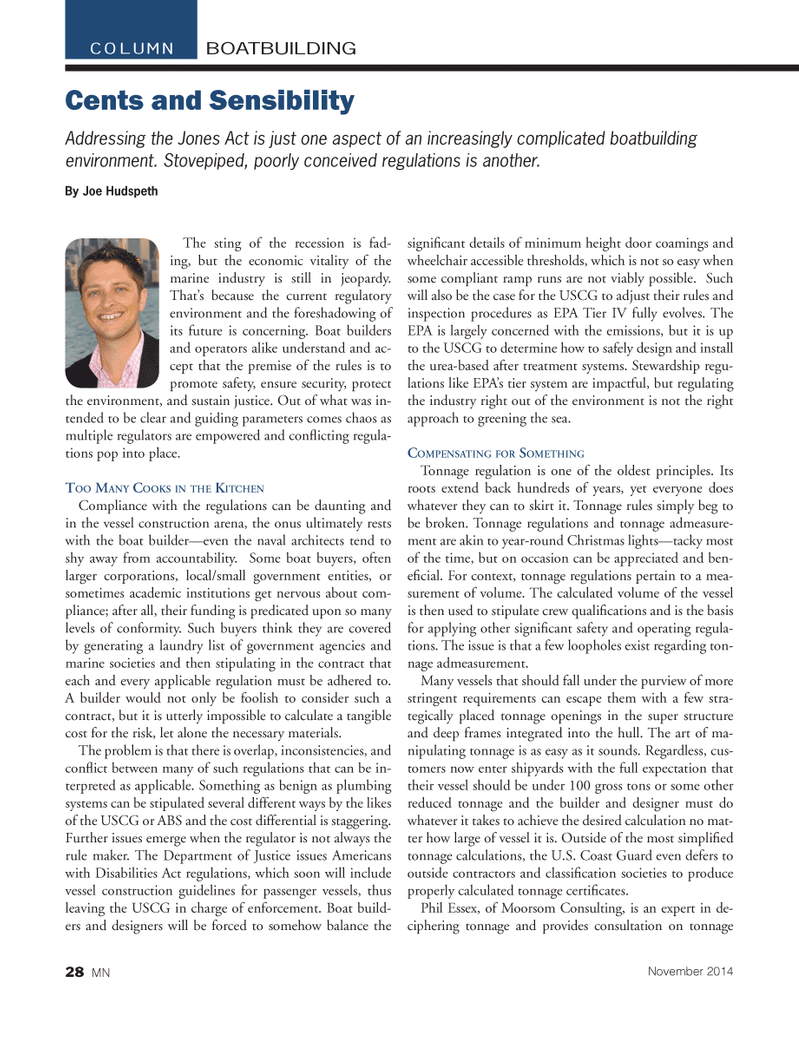
Page 28: of Marine News Magazine (November 2014)
Workboat Annual
Read this page in Pdf, Flash or Html5 edition of November 2014 Marine News Magazine
The sting of the recession is fad- ing, but the economic vitality of the marine industry is still in jeopardy.
That’s because the current regulatory environment and the foreshadowing of its future is concerning. Boat builders and operators alike understand and ac- cept that the premise of the rules is to promote safety, ensure security, protect the environment, and sustain justice. Out of what was in- tended to be clear and guiding parameters comes chaos as multiple regulators are empowered and confl icting regula- tions pop into place.
TOO MANY COOKS IN THE KITCHEN
Compliance with the regulations can be daunting and in the vessel construction arena, the onus ultimately rests with the boat builder—even the naval architects tend to shy away from accountability. Some boat buyers, often larger corporations, local/small government entities, or sometimes academic institutions get nervous about com- pliance; after all, their funding is predicated upon so many levels of conformity. Such buyers think they are covered by generating a laundry list of government agencies and marine societies and then stipulating in the contract that each and every applicable regulation must be adhered to.
A builder would not only be foolish to consider such a contract, but it is utterly impossible to calculate a tangible cost for the risk, let alone the necessary materials.
The problem is that there is overlap, inconsistencies, and confl ict between many of such regulations that can be in- terpreted as applicable. Something as benign as plumbing systems can be stipulated several different ways by the likes of the USCG or ABS and the cost differential is staggering.
Further issues emerge when the regulator is not always the rule maker. The Department of Justice issues Americans with Disabilities Act regulations, which soon will include vessel construction guidelines for passenger vessels, thus leaving the USCG in charge of enforcement. Boat build- ers and designers will be forced to somehow balance the signifi cant details of minimum height door coamings and wheelchair accessible thresholds, which is not so easy when some compliant ramp runs are not viably possible. Such will also be the case for the USCG to adjust their rules and inspection procedures as EPA Tier IV fully evolves. The
EPA is largely concerned with the emissions, but it is up to the USCG to determine how to safely design and install the urea-based after treatment systems. Stewardship regu- lations like EPA’s tier system are impactful, but regulating the industry right out of the environment is not the right approach to greening the sea.
COMPENSATING FOR SOMETHING
Tonnage regulation is one of the oldest principles. Its roots extend back hundreds of years, yet everyone does whatever they can to skirt it. Tonnage rules simply beg to be broken. Tonnage regulations and tonnage admeasure- ment are akin to year-round Christmas lights—tacky most of the time, but on occasion can be appreciated and ben- efi cial. For context, tonnage regulations pertain to a mea- surement of volume. The calculated volume of the vessel is then used to stipulate crew qualifi cations and is the basis for applying other signifi cant safety and operating regula- tions. The issue is that a few loopholes exist regarding ton- nage admeasurement.
Many vessels that should fall under the purview of more stringent requirements can escape them with a few stra- tegically placed tonnage openings in the super structure and deep frames integrated into the hull. The art of ma- nipulating tonnage is as easy as it sounds. Regardless, cus- tomers now enter shipyards with the full expectation that their vessel should be under 100 gross tons or some other reduced tonnage and the builder and designer must do whatever it takes to achieve the desired calculation no mat- ter how large of vessel it is. Outside of the most simplifi ed tonnage calculations, the U.S. Coast Guard even defers to outside contractors and classifi cation societies to produce properly calculated tonnage certifi cates.
Phil Essex, of Moorsom Consulting, is an expert in de- ciphering tonnage and provides consultation on tonnage
BOATBUILDINGCOLUMN
Cents and Sensibility
Addressing the Jones Act is just one aspect of an increasingly complicated boatbuilding environment. Stovepiped, poorly conceived regulations is another.
By Joe Hudspeth
November 2014 28 MN
MN Nov14 Layout 18-31.indd 28 10/23/2014 10:23:21 AM

 27
27

 29
29
